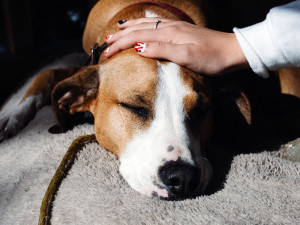Bromethalin Toxicity in Dogs
It might sound obvious, but these rodenticides are harmful to pups.
There has been a dramatic increase in pets dying from bromethalin, a harmful neurotoxin found in rodenticides. This rat poison is often used with peanut butter to attract rodents, but curious pups may also find themselves tempted by these potentially fatal poison pellets.
In 2008, the Environmental Protection Agency announced that it planned to restrict sales of certain rodenticides opens in new tab containing second-generation anticoagulants (such as brodifacoum and bromadiolone) to pest control professionals and agricultural supply stores only. Rodenticide manufacturers came up to speed with compliance in 2011 and, in doing so, began using bromethalin more and more instead of anticoagulants in their products.
Snap a pic of your pup’s teeth, and GREENIES™ will help you spot potential signs of oral health issues.
While the change was designed to make rodenticides safer for children, pets, and wildlife, some devastating consequences have also been found. Unlike anticoagulant rodenticides, bromethalin does not have an antidoteopens in new tab, and many people including some veterinarians are not aware of its toxicity. There has been an uptick in the number of cases treated since these regulations have been put in place.
How much do you spend on your pet per year?
Bromethalin Poisoning in Dogs
Before the regulation change, if a dog had ingested a rodenticide, it was likely an anticoagulant D-Con-like product. Anticoagulant toxicities are relatively easy and cheap to treat if caught early as there is a two to five day lag time before bleeding actually happens. An exposure to anticoagulants can be diagnosed with a simple blood test, known as a PT test, which checks the blood clotting time and confirms exposure even if you didn’t witness your dog eating it.
This is not, however, the case with new rodenticides. Bromethalin is a neurotoxin that affects the brain cells by causing a rapid influx of sodium particles into its cells. When this happens, body water follows the sodium particles and leads to swelling in the central nervous system. The symptoms come on much faster, and neurological signs can be seen within as little as 2 hours of ingestion. These signs can include depression, a “drunken” gait, rigid limbs, seizures, and coma. Because there is no antidote, treatment is aimed at decontamination, intensive and expensive hospitalization for support of the body, and treatment of clinical signs if they develop.
Bromethalin Toxicity Symptoms
Drunken gait
Incoordination
Tremors
Rigid limbs (paralysis)
What Should You Do If Your Dog Eats Bromethalin?
Despite how little was ingested, always assume the worst-case scenario and get your pet to the emergency veterinarian as soon as possible. Always bring any packaging to your veterinarian to help facilitate rapid treatment.
The severity of signs is dose-dependent, and if the poisoning is discovered within 30 minutes to an hour of ingestion, you should attempt to induce vomiting at home if you are not close to a veterinarian* — this will lessen the amount in the body, and therefore lessen the severity of signs.
In the worst-case scenario, your pup should be hospitalized on IV fluids for at least 24 hours, during which time multiple doses of charcoal will be given along with treatment for any brain swelling that develops. The lowest average lethal dose of bromethalin for dogs is 2.38 mg/kg, meaning a 10-pound dog could die from ingesting 5 small cubes of bait — not an uncommon feat.
A word of caution on inducing vomiting*
Trying to induce vomiting on your dog at home is not without risk, and there are words of caution to consider: Only attempt to induce vomiting if you know your pet consumed bromethalin, your pet is very alert, and if you are further than 1 hour away from your veterinarian.
If you need to induce vomiting at home, you can administer 1 ml of hydrogen peroxide per 1 pound of body weight with a maximum of 45 ml being given. For example, a 10-pound dog would need 10 ml of hydrogen peroxide, and the 80-pound dog should get no more than 45 ml. Don’t waste time waiting to see if your dog will vomit...gently give the peroxide, grab a blanket to cover your car seat, and begin driving immediately to your vet.
But do not force your dog to ingest peroxide; your pet needs to swallow the peroxide, and because it tastes bad, there is a risk of your pet aspirating the peroxide into the lungs if they resist and it is being forced. Another concern is the potential for aspiration during the vomiting process. Aspiration of peroxide during administration or through the process of vomiting leads to additional problems such as pneumonia.
You might be thinking, “Who would keep this stuff around when you have pets?” But you would be surprised by the number of dogs treated for this toxicity, especially given that the regulations specify that these poisons be sold with bait stations that securely contain the poison. This is a good reminder to be sure to pet-proof your lawn and garden chemicals, to reduce the risk of exposure but if at all possible, avoid using any rodenticide if you have pets or children.
This information is not meant to substitute for veterinary care or diagnosis. Always reach out to your veterinarian with any questions or concerns.







